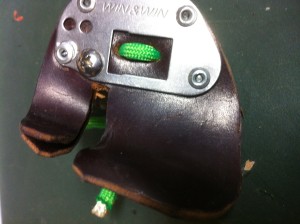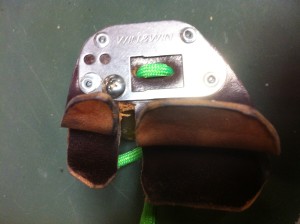A shooter’s tab is one of the most important and highly modified pieces of equipment an archer will own. What should you look for and how should you modify your tab to fit your hand?
Your first consideration should be how large a tab to buy. The leather should cover your fingers without excess length. If you have doubt, try to order the tab with a longer length of leather and trim to fit. Leave the second layer a bit longer than the first layer, as when the tab is used, the second layer will have to travel just a bit longer as your fingers curl.
While still considering tab size, you should look at the metal plate. It should be a size that allows you to have stability without being too large to achieve a tight anchor. If it is too large, the plate will rub your face. Of course you can grind the plate to fit, but it is much easier to buy the correct size.
Now that you have a correctly sized tab, look at the spacer. Most archers are greatly aided by using a spacer. It prevents you from having unwanted contact with the arrow. Many archers swap the stock spacer for one that fits their hand better. A comfortable spacer, which fits your hand allows for more comfortable and accurate shooting.
Should you use a shelf, or not? This is usually determined by an archer’s facial structure. The steeper the jaw line, the more likely you’ll opt for a shelf. This is something you and your coach should examine carefully.
The system which affixes the tab to your finger is often highly modified. It should allow you to position the tab on your hand in a consistent manner. Some shooters will have multiple finger clasps, while others prefer a single finger strap. It really doesn’t matter, as long as you are able to accurately reproduce the same hand-tab-string placement.
The space between the index finger and middle finger on the tab is almost always modified. Most stock tabs, especially the beginner tabs, have inadequate room between the index and middle finger. This causes contact between the tab and arrow. The beginning archer will often have trouble keeping his arrow on the rest and the tab can be the culprit. Trim the leather between the index and middle finger until their is no contact with the arrow.
There are additional tab considerations, such as how many layers of leather should be used. By the time you’re considering this question, you’ll have a good idea about which modifications to make.
In the pictures below, a Win & Win 360 tab, is shown with many modifications. The leather has been replaced with upgraded Cordovan. The clasp system has been swapped for a simpler para cord cinch. The kerf has been widened. The only stock items are the plate and spacer. Such is the nature of making the tab fit the archer.







